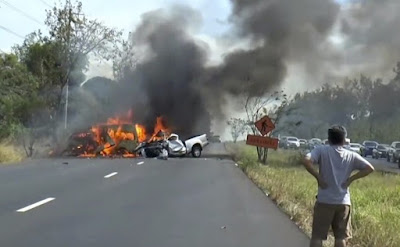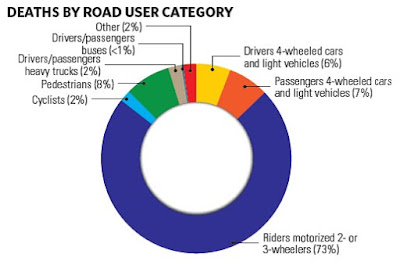
In this image made from video, a man watches as two vehicles burn after they collided on a highway east of Bangkok, Thailand, Monday, Jan 2, 2017. Source: Matichon TV via AP
How can Thailand curb its appalling road fatality rate?
By Fergal Barry-Murphy |
5th January 2017
Source: Asian Correspondent
THAILAND’s already dismal road safety record sank to new lows over the New Year holiday period as more than 400 people lost their lives in traffic accidents.
In the worst of the incidents, 25 people died on Monday in Chonburi province after a pick-up truck and a minivan collided and burst into flames.
In all, 426 people died on Thailand’s road between Dec 29 and Jan 3, up from 340 in the same period a year earlier.
“Unfortunately the number of fatalities has increased despite a campaign from the government and law enforcement to increase safety,” government spokesman Weerachon Sukondhapatipak told Reuters.
“Road safety is something we will have to continue working on continuously and not just during the new year period.”

A van and a pickup collided and caught fire on a highway in eastern Thailand, killing 25 people on Jan 2, 2017. Source: Matichon TV via AP
Often dubbed the ‘seven days of death’, the New Year period is an annual blot on the country’s already abysmal road safety record.
Last year, the World Health Organization reportedthat Thailand was second only to Libya in terms of per capita road fatalities with an estimated average of 66 deaths a day in 2012 — about 24,000 in total, far higher than the official figure of 14,059.
Further, up to a million people are thought to be injured on Thailand’s roads each year.
If anything, the situation has deteriorated since 2012. In April last year, 442 people died on Thailand’s roads during the festive Songkran week, the highest death toll in 10 years.

While the current ruling junta inherited this problem, it has failed so far to effectively address the issue despite a number of measures, including increased enforcement, awareness campaigns, and even free food.
So far, it does not appear to be working.
In a typically knee-jerk reaction to the horrific incident in Chonburi, the junta has mooted a ban on minivans, a measure unlikely to have any real impact.
While minivan drivers have a reputation for reckless driving and driving dangerously long distances at a time, they are just a small part of a very large problem.

The World Health Organisation (WHO) has estimated that 83 percent of people killed on Thailand’s roads are “vulnerable road users” — pedestrians, cyclists and motorcyclists. Of these, motorcycles account for the vast majority of deaths – 73 percent of all road fatalities.
Despite a concerted effort by authorities to increase awareness and step up enforcement, many motorcyclists in Thailand do not wear helmets and only face paltry fines (often in the form of a back-hander) for the infraction. WHO estimates only 52 percent of motorcycle drivers and 20 percent of passengers wear helmets.
While enforcement of this and other road safety regulations has improved in recent years, it is still sadly lacking. Police checks often take the form of stationary roadblocks, while drink driving, speeding and even driving without a license remain commonplace. Small fines and the ability for offenders to bribe their way out of situations means there is little real deterrent to breaking the law.
WHO has identified the need for increased enforcement and/or legislative change related to five main risk factors: speed, drink-driving, helmets, seat belts and child restraints. And while there has been some progress in this regard, little real change is likely without proper enforcement and real deterrents to make sure the law is obeyed.
Perhaps one of the most serious problem of all is that many young drivers on Thailand’s roads have little or no experience when they start driving.

A young boy and his siblings ride a motorcycle without helmets in Loei province, Thailand. Source: Migel/Shutterstock.com
Source: Asian Correspondent
THAILAND’s already dismal road safety record sank to new lows over the New Year holiday period as more than 400 people lost their lives in traffic accidents.
In the worst of the incidents, 25 people died on Monday in Chonburi province after a pick-up truck and a minivan collided and burst into flames.
In all, 426 people died on Thailand’s road between Dec 29 and Jan 3, up from 340 in the same period a year earlier.
“Unfortunately the number of fatalities has increased despite a campaign from the government and law enforcement to increase safety,” government spokesman Weerachon Sukondhapatipak told Reuters.
“Road safety is something we will have to continue working on continuously and not just during the new year period.”

A van and a pickup collided and caught fire on a highway in eastern Thailand, killing 25 people on Jan 2, 2017. Source: Matichon TV via AP
Often dubbed the ‘seven days of death’, the New Year period is an annual blot on the country’s already abysmal road safety record.
Last year, the World Health Organization reportedthat Thailand was second only to Libya in terms of per capita road fatalities with an estimated average of 66 deaths a day in 2012 — about 24,000 in total, far higher than the official figure of 14,059.
Further, up to a million people are thought to be injured on Thailand’s roads each year.
If anything, the situation has deteriorated since 2012. In April last year, 442 people died on Thailand’s roads during the festive Songkran week, the highest death toll in 10 years.

While the current ruling junta inherited this problem, it has failed so far to effectively address the issue despite a number of measures, including increased enforcement, awareness campaigns, and even free food.
So far, it does not appear to be working.
In a typically knee-jerk reaction to the horrific incident in Chonburi, the junta has mooted a ban on minivans, a measure unlikely to have any real impact.
While minivan drivers have a reputation for reckless driving and driving dangerously long distances at a time, they are just a small part of a very large problem.

The World Health Organisation (WHO) has estimated that 83 percent of people killed on Thailand’s roads are “vulnerable road users” — pedestrians, cyclists and motorcyclists. Of these, motorcycles account for the vast majority of deaths – 73 percent of all road fatalities.
Despite a concerted effort by authorities to increase awareness and step up enforcement, many motorcyclists in Thailand do not wear helmets and only face paltry fines (often in the form of a back-hander) for the infraction. WHO estimates only 52 percent of motorcycle drivers and 20 percent of passengers wear helmets.
While enforcement of this and other road safety regulations has improved in recent years, it is still sadly lacking. Police checks often take the form of stationary roadblocks, while drink driving, speeding and even driving without a license remain commonplace. Small fines and the ability for offenders to bribe their way out of situations means there is little real deterrent to breaking the law.
WHO has identified the need for increased enforcement and/or legislative change related to five main risk factors: speed, drink-driving, helmets, seat belts and child restraints. And while there has been some progress in this regard, little real change is likely without proper enforcement and real deterrents to make sure the law is obeyed.
Perhaps one of the most serious problem of all is that many young drivers on Thailand’s roads have little or no experience when they start driving.

A young boy and his siblings ride a motorcycle without helmets in Loei province, Thailand. Source: Migel/Shutterstock.com
Many drive without licenses and those who do have one need only to pass a notoriously easy test. While some questions were added to the theory test in 2014, drivers only need to show rudimentary driving skills in an enclosed area to pass to the test and are issued a license immediately with no restrictions.
With no real attempt by authorities to instill good driver etiquette and responsible behavior, Thailand’s roads will continue to be in inherently dangerous.
With almost three people dying on Thailand’s roads every hour, road safety remains one of Thailand’s greatest public health challenges. So far, it has fallen far short in of achieving its stated goals in the reduction of road fatalities.
SEE ALSO: 39 deaths per day: New study says Thailand’s roads 2nd-deadliest in the world

.jpg)





